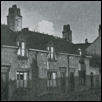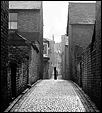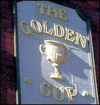 |
Hulton
Abbey to Ruston Grange
This walk examines Hulton Abbey, the trackway along Sneyd Street and the
monks farmland at Ruston Grange.
The Abbey was founded
by Henry De Audley in 1219 and consecrated in 1223. Following the
dissolution in 1538 the site eventually was lost until 1884; it was
located during a chance excavation, later being investigated and published
by Charles Lynam who was a local architect.
|
 |
The Newcastle-under-Lyme Junction Canal was proposed in 1789 as a
third canal, one of its main promoters was Nigel Gresleys' son.
The route was planned to be
a link canal from the Nigel Gresley Canal to the Newcastle Under Lyme
Canal. At the southern end of the Junction Canal a railway inclined plane
was planned because the Newcastle Under Lyme Canal was some 60 feet lower
than the Junction Canal.
|
 |
Grove Road, Heron Cross, Great Fenton
It is not at
all fanciful to speculate that a number of famous and early potters
journeyed along the track which is today known as Whieldons Road, Grove
Road and Duke Street.
|
 |
Normacot
Road, Longton
Normacot Road was once an important thoroughfare from Normacot to Longton
Town. Many of the houses and works
were demolished between the 1930's and the 1970's and the opening of the
A50 road in 1997 meant that the end of Normacot Road was sealed off - so
now it is a road to nowhere.
|
 |
Lord Street (Etruria Old Road)
Josiah Wedgwood set an example by building houses for his workers. There
may have been an element of philanthropy here, but it was also a necessity
if skilled men were to be enticed to Etruria from Burslem. The terraced
houses stretched along both sides of the main road from Etruria to Basford
Bank.
|

|
Fowlea
Bank, Basford
In the Etruria valley runs
the Fowlea Brook, the turnpike road (now Etruria Road) to the left climbs
a ridge, rising 500ft to Basford.
Basford Bank as we know it
now was not built until 1820, prior to that the turnpike road ran along a
steep route "Fowlea Bank" which still exists today behind the houses
fronting Basford Bank.
|
 |
Paradise
Street, Tunstall
"Specially noteworthy are the two terraces,
each of 20 houses, which form the south side of Paradise Street and the
north side of Piccadilly Street at the west end of Tower Square. They were
built in 1821 by the Tunstall Building Society which had been formed in
1816 with 32 members, many of them working potters."
|
 |
The Ash Estate was a
strategic location in the mid nineteenth century because the
Bridle Path was the route of coal carts from Hanley Hayes Colliery
to the Hanley-Cheadle Turnpike Road.
The exploitation of the coal seams under the estate - reflected in
the names of the fields: “Coal Pit Field” and “Slack Pit Field” —
helped to pay for the construction of the new Ash Hall estate
buildings and the enlargement of the estate.
|
|
 |
Pall
Mall, Hanley
As early as 1818 Pall Mall existed as New Street,
Shelton.
Although now a
desolated street at one time it was a busy place with a large number
of public buildings.......The Free Library, the North Staffs.
Technical and Art Museum, the Government School of Art, the
Potteries Mechanics’ Institution, and the Theatre Royal were all situated
in Pall Mall.
|
 |
Bridle Path, Dresden
When the Longton Freehold Land Society bought the land a bridle
path leading from Longton to Trentham ran across the land. This
was incorporated into the building plan as a pedestrian road
between Belgrave Road and Ricardo Street.
Following this bridle path will take us on a walk through the
history of British social reform politics.......
|
 |
Old
Town Road, Hanley
The High Street, Hanley ran
from Market Square to Providence Square in the early 1950's High
Street was renamed Town Road
The part of Town Road near Hanley Deep Pit colliery
was moved to provide feeders to the Potteries Way and the top part of
Town Road was renamed to "Old Town Road"
|
 |
Bournes Bank, Burslem
Once part of a packhorse road
which ran from Hanley through onto Church Lawton. Bournes
Bank was originally called Church Street and was the main path
down to St. John's Church and then on to Hanley.
Many pottery and related industry buildings and businesses thrived
on Bournes Bank. A school, an ice skating rink and two cinemas
found their home on this unassuming road. |